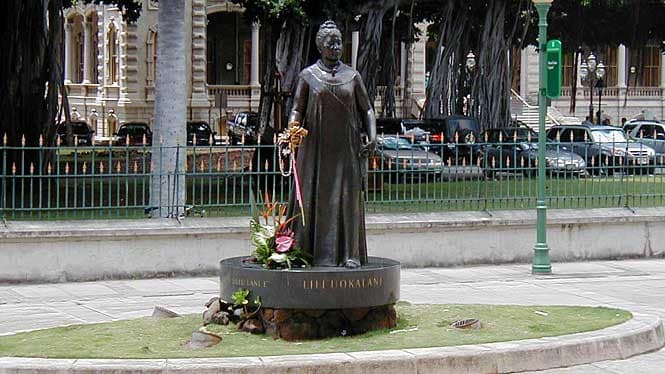Hawaii’s last sovereign queen was born on September 2, 1838, in Honolulu. According to Hawaiian tradition, she was adopted at birth by Abner Paki and his wife, Konia (a granddaughter of King Kamehameha I). Liliuokalani’s childhood years were spent studying and playing with Bernice Pauahi, the Pakis’ natural daughter.
Liliuokalani received her education at the Royal School and became fluent in English. She was also a member of the Kawaiahao Church, which was built under the direction of Hiram Bingham, the leader of the first group of missionaries to Hawaii in 1820. In 1862, she married John Owen Dominis, the son of an American sea captain.

History
In 1874, Liliuokalani’s brother, David Kalakaua, was elected as Hawaii’s new king. One of his first acts was to name William Pitt Leleiohoku as his heir; just three years later, however, the crown prince died at the age of 23. Liliuokalani was now directly in line for the throne.
Kalakaua himself died in January 1891 in San Francisco. On January 29, the USS Charleston was sighted off Diamond Head, its hull draped in black and the Hawaiian flag at half-staff. Suddenly, the Hawaiians knew: Their king was dead. Government ministers insisted that Liliuokalani immediately sign an oath to uphold the constitution that had been forced upon her brother.
Under the constitution, Liliuokalani wielded little power. She formed a Cabinet three times, and each time it was rejected by the Legislature. She drafted a strong royalist constitution, but no one supported it.
Finally, on January 17, 1893, pro-American forces overthrew the government and proclaimed a provisional government with Sanford B. Dole as president. Liliuokalani had no choice but to surrender her throne. She made a plea to the U.S. government for reinstatement, and a representative of President Grover Cleveland found the overthrow to be illegal. Dole, however, refused to accept the decision.
The queen withdrew to her residence, Washington Place, and urged her supporters to be patient and avoid bloodshed. A fierce uprising was firmly squelched in January 1895, and although she denied playing a role in the attempted takeover, Liliuokalani was arrested and taken to a second-floor room at Iolani Palace. It would serve as her jail cell for nearly a year. During her confinement, the queen wrote one of Hawaii’s most beloved songs, “Aloha Oe” (“Farewell to Thee”).
Liliuokalani was pardoned in October 1896. In her remaining years, the deposed queen fought for the restoration of the Hawaiian kingdom. She died in 1917 at age 79.